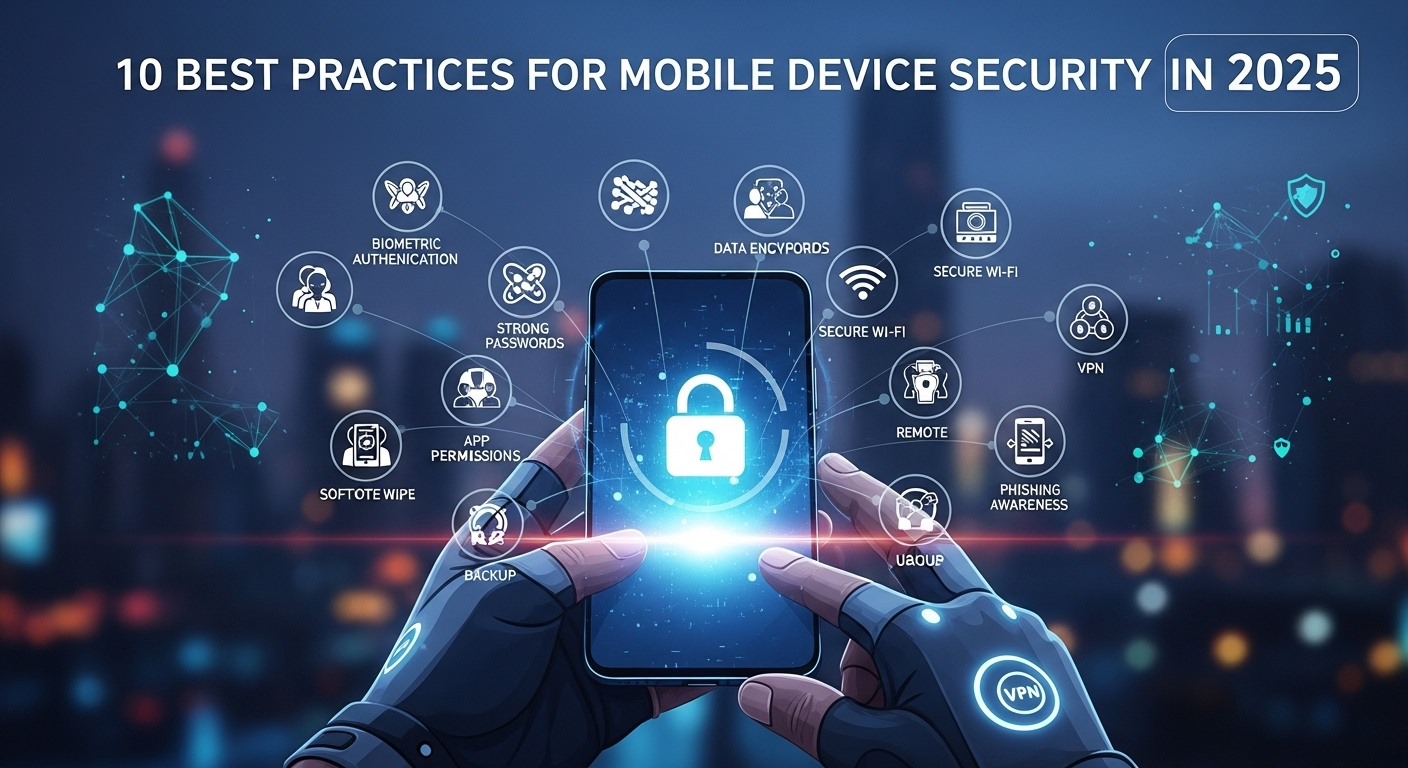Best practices for mobile device security are no longer optional — they are essential. As mobile devices become the primary computing platform for users and enterprises alike, securing them against evolving threats requires layered defenses, up-to-date policies, and ongoing monitoring.
H2: Why mobile device security matters in 2025
Mobile devices now store sensitive personal and corporate data, access cloud services, and control IoT endpoints. That ubiquity makes them high-value targets for attackers. Compromised mobile devices can lead to identity theft, corporate breaches, ransomware, and supply-chain compromises. For long-term resilience, organizations and individuals must adopt proven security patterns and the latest defensive technologies.
The threat landscape has shifted. Attack vectors such as smishing, rogue apps, malicious SDKs, and SIM-swapping remain common, while AI-assisted phishing and automated malware distribution are increasing. Meanwhile, broader changes — widespread 5G, eSIM adoption, and complex app ecosystems — create both opportunities and new security considerations. Adopting the best practices for mobile device security reduces risk and improves incident response readiness.
Regulatory and business drivers also influence priorities. Privacy regulations (e.g., GDPR-like frameworks), industry compliance requirements, and customer expectations demand demonstrable safeguards. Organizations that invest in mobile security gain not only risk reduction but also competitive trust advantages.
H2: Device hardening and authentication
Device-level protections are the foundation of mobile security. Start by ensuring devices use the latest OS versions and security patches — unpatched devices are one of the most exploited weaknesses in mobile fleets. Combine system updates with hardware-backed protections like secure enclaves and verified boot to raise the bar for attackers.
- Strong authentication and biometrics
Biometric authentication (fingerprint, face) and multi-factor authentication (MFA) dramatically reduce account takeover risk. Biometrics tied to hardware-backed keystores prevent credential extraction. Use MFA for cloud apps, VPNs, and device unlock. While biometrics improve usability, always offer fallback MFA (PIN + hardware token) for accessibility and redundancy.
Biometric systems must be implemented with privacy and anti-spoofing in mind. Configure timeouts and re-authentication windows for high-risk operations (e.g., financial transactions). Where possible, adopt standards-based approaches (FIDO2/WebAuthn) to reduce reliance on passwords and provide stronger cryptographic authentication.
- Secure boot, encryption, and lock screens
Enable full-disk or file-based encryption to protect data at rest. Most modern mobile OSes provide built-in encryption tied to device credentials; ensure it’s active and enforced. Secure boot and hardware attestation ensure the device boots trusted code and hasn’t been tampered with.
Configure lock-screen policies that require strong passcodes, limit failed attempts, and enforce auto-lock intervals. For enterprise devices, use remote wipe capabilities and selective wipe for BYOD scenarios to protect corporate data without deleting personal content unnecessarily.
- Disable risky features and services
Reduce attack surface by disabling unused hardware features — e.g., Bluetooth, NFC, or location services — when not needed. Lock down side-loading and developer options in managed environments to prevent unauthorized app installs. For highly sensitive use cases, limit external storage and USB debugging. Minimizing enabled services reduces vectors for malware and exploitation.
H2: App security and data protection
Apps are the primary conduit for both productivity and risk. Vet apps, control installations, and defend the app supply chain to mitigate threats from malicious or compromised software.
- Curate and manage apps
Use enterprise app stores or managed deployment to push approved apps to staff. Maintain a whitelist/blacklist strategy and require app vetting that examines permissions, network behavior, and embedded third-party SDKs. Avoid allowing apps from untrusted sources or side-loading in corporate environments.
App vetting should include regular rescans because SDK updates or compromised ad networks can introduce risks post-deployment. Encourage users to install only apps from trusted marketplaces and to review app permissions — minimal permissions equal minimal risk.
- Containerization and data separation
On BYOD devices, implement containerization or application-level encryption to isolate corporate data from personal content. Containers preserve privacy while enabling controls like copy/paste restrictions, conditional access, and selective remote wipe. This approach reduces friction while maintaining corporate data protection.
For corporate-owned devices, consider full device management with stronger controls. Always encrypt sensitive app data in transit and at rest, and ensure keys are stored in hardware-backed secure elements where possible.
- Protecting the app supply chain
Third-party SDKs and development pipelines are frequent vectors for supply-chain attacks. Apply code signing, dependency scanning, and secure CI/CD practices to prevent malicious code from reaching production builds. Use runtime application self-protection (RASP) and mobile threat defense (MTD) agents to detect anomalous behavior from apps after deployment.
H2: Network and connectivity security
Network-level controls are essential because many attacks use network-based techniques: man-in-the-middle, rogue Wi‑Fi, DNS manipulation, and insecure API endpoints. Secure network connections and inspect traffic where appropriate.
- Use secure, private connections and DNS protections
Always protect data-in-transit with TLS and enforce certificate pinning for critical apps. For users on public Wi‑Fi, require VPN or use per-app VPNs to limit exposure. DNS filtering and secure DNS (DoT/DoH) block known malicious domains before connections occur.
Organizations should deploy enterprise-grade VPN solutions combined with split-tunneling policies only where necessary. For cloud-native apps, zero trust network access (ZTNA) can replace traditional VPNs with contextual access controls that reduce lateral movement and exposure.
- Mitigate mobile-specific network attacks
Guard against SIM-swap and SS7 vulnerabilities by enabling carrier-level protections, using port freezes, and avoiding SMS-based authentication for high-value accounts. Implement runtime threat detection to spot suspicious network behavior from apps (e.g., data exfiltration to unknown IPs).
5G increases bandwidth and attack surface but also enables network slicing and improved isolation. Evaluate carrier security features and apply network segmentation principles where possible.
- Secure APIs and backend services
Mobile apps rely heavily on cloud APIs. Enforce robust authentication, rate-limiting, input validation, and least-privilege API keys. Monitor for abnormal API use patterns that may indicate compromised clients. Regularly perform penetration testing and API fuzzing as part of the security lifecycle.
H2: Management, policy, and governance
Technical controls must be paired with governance: policies, training, and lifecycle management. Structured mobile device management reduces operational risk and ensures consistent enforcement.

- MDM/UEM adoption and best practices
Adopt a modern device management platform (MDM/UEM) to enforce configurations, deploy apps, and audit compliance. Use conditional access policies that evaluate device posture (OS version, jailbreak/root status, MTD alerts) before granting access to sensitive resources.
Below is a comparison table to help choose between common management approaches:
| Feature / Policy | MDM (Mobile Device Management) | EMM (Enterprise Mobility Mgmt) | UEM (Unified Endpoint Mgmt) |
|---|---|---|---|
| Device configuration & policies | High | High | High |
| App distribution & containerization | Moderate | High | High |
| Endpoint unification (mobile+PC) | Low | Moderate | High |
| Support for IoT/edge devices | Low | Moderate | High |
| Best for | Mobile-first environments | Mobile + app control | Unified enterprise estates |
Choose the platform that aligns with your scale, device diversity, and security posture requirements. For many organizations, UEM is the strategic direction because it consolidates endpoint controls across mobile and desktop.
- Policies, BYOD, and legal considerations
Create clear BYOD policies that define acceptable use, privacy expectations, and incident response steps. For BYOD, favor containerization and selective wipe to balance privacy and security. Ensure policies comply with applicable privacy laws and labor regulations.
Train HR and legal teams to collaborate with IT security so device policies are enforceable and respectful of employee rights. Include device acceptance checklists and onboarding steps to ensure new devices meet baseline security requirements before accessing corporate resources.
- Continuous auditing and compliance
Use automated compliance checks and dashboards to maintain visibility into device posture. Regularly audit device inventories, installed apps, and security configurations. Integrate mobile telemetry into SIEM/XDR systems for centralized alerting and correlation. Maintain documented processes for patch management, decommissioning devices, and responding to breaches.
H2: Threat detection, response, and resilience
Fast detection and coordinated response reduce the damage when incidents occur. A layered detection strategy is critical: endpoint sensors, network analytics, and cloud monitoring.
- Mobile threat defense and telemetry
Deploy Mobile Threat Defense (MTD) tools that detect malware, network attacks, and device compromise signals. MTD can identify suspicious app behavior, root/jailbreak attempts, and man-in-the-middle proxies. Feed MTD alerts into centralized security operations to enable correlation with other threat data.
MTD solutions are complementary to MDM/UEM — they provide runtime visibility that static policies cannot. For high-risk environments, combine MTD with behavioral analytics to detect subtle exfiltration patterns.
- Incident response and remote remediation
Have a documented mobile incident response plan that includes containment (e.g., blocking device access), investigation (collecting logs and telemetry), remediation (remote wipe or reimage), and communication (stakeholders and users). Test playbooks regularly with tabletop exercises.
Remote actions — lock device, revoke tokens, disable accounts — should be executed quickly. Ensure backups and recovery paths exist so data loss is minimized during remediation. For compromised devices, require re-enrollment and revalidation before restoring access.
- Building resilience and business continuity
Plan for device loss or mass compromise scenarios by implementing redundancy: MFA methods beyond SMS, alternate admin channels, and emergency access procedures. Maintain an inventory of critical mobile apps and recovery steps to restore functionality after a widespread incident.
H2: Emerging trends and future-proofing mobile security
Mobile security is evolving rapidly. To stay relevant in 2025 and beyond, adopt forward-looking strategies that account for new technologies and threats.
- Zero Trust and contextual access
Zero Trust principles — verify explicitly, use least privilege, and assume breach — adapt well to mobile contexts. Implement contextual access that evaluates device posture, user behavior, location, and risk signals before granting access. Zero Trust reduces reliance on network perimeter and improves control over mobile access to cloud services.
- AI, ML, and automation
AI-driven threat hunting and anomaly detection improve detection of subtle attacks like credential stuffing or atypical API use. Automate routine remediation (e.g., quarantine device, revoke tokens) to speed response. However, be aware that attackers also use AI to craft sophisticated social engineering; defensive AI must be continually refined.
- Hardware evolution and standards
Hardware-backed keys, secure elements, and platform attestation become more ubiquitous. eSIMs and multi-profile SIMs simplify provisioning but require new protections against remote provisioning abuse. Support and adopt standards such as FIDO2, certificate-based authentication, and hardware attestation to future-proof security investments.
FAQ — Q & A
Q: How often should mobile OS and apps be updated?
A: Update the OS as soon as vendor patches are available for critical vulnerabilities; aim for a managed rollout within 7–30 days depending on severity. Apps should be updated regularly — enforce app updates for critical enterprise apps and use patch management to ensure compliance.
Q: Is MDM enough for mobile security?
A: MDM provides strong configuration and deployment controls but is not sufficient alone. Combine MDM/UEM with Mobile Threat Defense, endpoint telemetry, secure network controls, and governance for a comprehensive approach.
Q: Can BYOD be secured without invading employee privacy?
A: Yes. Use containerization and selective wipe to separate corporate and personal data. Clearly communicate policies, obtain consent where required, and avoid measures that collect unnecessary personal data.
Q: Should we rely on SMS-based MFA?
A: No. SMS-based MFA is vulnerable to SIM-swapping and interception. Use app-based authenticators, hardware tokens, or FIDO2 keys for high-value accounts.
Conclusion
Mobile device security in 2025 demands a layered, pragmatic approach: harden devices, secure apps and data, protect connectivity, enforce policies with modern management tools, and build robust detection and response capabilities. No single control is sufficient; the strongest defenses combine hardware-level protections, strong authentication, vetted applications, network safeguards, and continuous monitoring. By implementing these best practices for mobile device security, organizations and individuals can reduce risk, satisfy regulatory requirements, and maintain resilient access to critical services.
Summary (English)
This article outlines the "10 Best Practices for Mobile Device Security in 2025" across multiple domains: device hardening and authentication, app and data protection, network and connectivity security, management and governance, threat detection and response, and future-proofing strategies. Key recommendations include enforcing OS updates and hardware-backed encryption, using strong MFA and biometrics (preferably FIDO2), curating apps and isolating corporate data via containerization, securing networks with VPN/zero trust and DNS protections, adopting MDM/UEM plus Mobile Threat Defense, and preparing incident response playbooks. Emerging trends such as AI-assisted detection, zero trust, and hardware attestation are also emphasized. The article includes a comparison table of MDM/EMM/UEM, a Q&A FAQ, and a strong conclusion stressing layered defenses and continuous monitoring to stay resilient against evolving mobile threats.
















